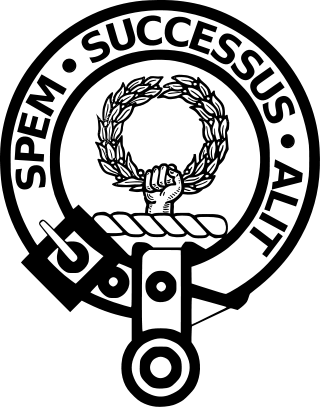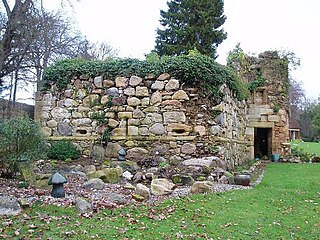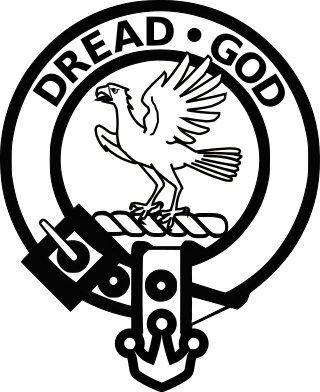Related Research Articles

Clan Ross is a Highland Scottish clan. The original chiefs of the clan were the original Earls of Ross.
Colonel Robert Munro of Foulis, also known as the Black Baron, was traditionally the 18th Baron of Foulis in Scotland. He was a soldier of fortune, who served in Germany under the banners of Gustavus Adolphus, king of Sweden. It is not certain how he got his epithet of the 'Black Baron', but quite possibly it was from the colour of his hair rather than any perceived martial ferocity. Although this Robert Munro is traditionally 18th Baron and 21st overall chief of the Clan Munro, he is only the 11th Munro chief that can be proved by contemporary evidence.
The Munros of Milntown were a family cadet branch of the Highland Clan Munro. As the earliest recorded cadet branch of the Munro chiefs, the Munros of Milntown were the 'senior' cadet branch of the clan, and spawned many cadet branches. They were frequently recorded as 'Monro' as well as Munro. The Munros of Milntown are notable for being involved in events concerning the history of the late Middle Ages in the Scottish Highlands.
Sir Robert Munro, 5th Baronet of Foulis was also 23rd Baron and 26th chief of the Clan Munro. He became blind and was known as the Blind Baron.

Kiltearn is a parish in Ross and Cromarty, Scotland. It is in the Presbytery of Ross.
Sir George Munro of Culcairn was a Scottish soldier of the 18th century from Ross-shire, Scotland. He commanded the 3rd Independent Highland Company from 1714 to 1716, fought at the Battle of Glen Shiel in 1719, led the 6th Company in formation of the "Black Watch" in 1725, the 8th Company of Black Watch when it was regimented in 1739 and again commanded an Independent Highland Company in 1745–46. He was shot in error in 1746.

Sir George Munro, 1st of Newmore (1602–1693) was a 17th-century Scottish soldier and member of parliament from the Clan Munro, Ross-shire, Scotland. He was seated at Newmore Castle. Between 1629 and 1634 Munro held command in the Swedish army during the Thirty Years' War, and from 1642 in the Scottish Covenanter army during the Irish Confederate Wars before changing his allegiance to the Royalist cause of Charles I in 1648 during the Scottish Civil War and Irish Confederate Wars.

The Battle of Achnashellach was a Scottish clan battle said to have taken place in the year 1505, in the Scottish Highlands at Achnashellach. It was fought by the Clan Cameron against the Clan Mackay and the Clan Munro.
Robert Mor Munro, 15th Baron of Foulis, and 18th chief of the Clan Munro was a 16th-century Scottish chief. He was known as Robert Mor on account of his large stature. He was the eldest son of Robert Munro, 14th Baron of Foulis. Although this Robert Munro is traditionally 15th Baron and 18th overall chief of the clan, he is only the 8th Munro chief that can be proved by contemporary evidence.

There have been three baronetcies created for persons with the surname Munro, one in the Baronetage of Nova Scotia and two in the Baronetage of the United Kingdom.
Sir Robert Munro, 3rd Baronet of Foulis, 21st Baron and 24th chief of the Clan Munro was a 17th-century Scottish soldier and politician.
Robert Munro, 14th Baron of Foulis was a Scottish soldier and clan chief of the Highland Clan Munro. He was seated at Foulis Castle. Although he is traditionally the 14th Baron and 17th overall chief of the clan, he is only the 7th Munro chief that can be proved by contemporary evidence.

The chiefs of the Scottish highland Clan Munro, the Munros of Foulis, are according to tradition, descended from a Donald Munro of Foulis who died in 1039. However, their descent can only be proved by contemporary evidence back to a Robert de Munro who died in 1369.
Sir Hector Munro, 1st Baronet of Foulis was a Scottish soldier, noble and clan chief of the highland Clan Munro. He is also by tradition the 19th Baron and 22nd overall chief of the clan. He is however the 12th chief of the Clan Munro who can be proved by contemporary evidence.

The Munros of Obsdale were a Scottish family and a cadet branch of the Clan Munro, a Highland Scottish clan. Their base was at Obsdale House, situated just north of the town of Alness in the Scottish Highlands. Some of the members of the Munro of Obsdale family were amongst the most distinguished Scottish military officers of the 17th century.

Clan Munro is a Highland Scottish clan. Historically the clan was based in Easter Ross in the Scottish Highlands. Traditional origins of the clan give its founder as Donald Munro who came from the north of Ireland and settled in Scotland in the eleventh century, though its true founder may have lived much later. It is also a strong tradition that the Munro chiefs supported Robert the Bruce during the Wars of Scottish Independence. The first proven clan chief on record however is Robert de Munro who died in 1369; his father is mentioned but not named in a number of charters. The clan chiefs originally held land principally at Findon on the Black Isle but exchanged it in 1350 for Estirfowlys. Robert's son Hugh who died in 1425 was the first of the family to be styled "of Foulis", despite which clan genealogies describe him as 9th baron.
John Munro, 2nd of Lemlair was a Scottish soldier who fought as a colonel in the Wars of the Three Kingdoms. His seat was at Lemlair House.
The Munros of Culrain were a minor noble Scottish family and a cadet branch of the ancient Clan Munro, a Scottish clan of the Scottish Highlands. They were seated at Culrain which is in the south of the county of Sutherland, but to the north of the main Munro clan lands in Kiltearn, Easter Ross.
The Munros of Kiltearn were a minor noble Scottish family and a branch of the ancient Clan Munro, a Scottish clan of the Scottish Highlands.They were seated at Kiltearn House which was a manor house that shared the same name of the parish it was situated in, Kiltearn. In Scottish Gaelic the Munros of Kiltearn are known as the Sliochd-Alastair-Mhic-Uistean. The most famous member of the Munro of Kiltearn family was Donald Monro, High Dean of the Isles.
Thomas Mackenzie of Pluscarden, also known as of Pluscardine was a Scottish soldier and member of parliament of the 17th century. He was a member of the Clan Mackenzie, a Scottish clan of the Scottish Highlands.
References
- 1 2 Mackenzie, Alexander (1898). History of the Munros of Fowlis. Inverness: A. W Mackenzie. pp. 86-87. Retrieved 15 April 2020.
- 1 2 3 4 5 6 7 8 Munro, R.W (1978). The Munro Tree 1734. Edinburgh. p. 20 - on opposite unnumbered page - paragraph V. ISBN 0-9503689-1-1.
{{cite book}}: CS1 maint: location missing publisher (link) - ↑ Munro, R.W, ed. (1955). "Clan Munro Magazine - The Munro Levies at Carbisdale" (5). Clan Munro Association: 33, 36.
{{cite journal}}: Cite journal requires|journal=(help) - ↑ Morrison, Hew L.L.D, ed. (1911). Parish Register of Durness 1764-1814. Edinburgh: Printed for the Scottish Record Society by James Skinner & Company. p. 11 . Retrieved 15 April 2020.
- ↑ Grannd, Seumas (2013). Gaidhlig Dhuthaich Mhich Aoidh - The Gaelic of the Mackay Country dialect and vocabulary. Glasgow: Bell & Bain Limited. pp. 24, 43, 108, 156. ISBN 978-1-900901-60-4.